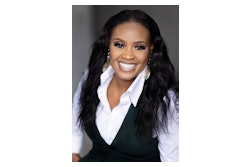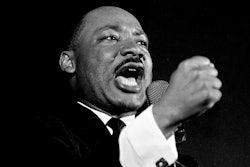A professor of dance at Temple University, Brenda Dixon Gottschild draws upon her expertise in that discipline as a springboard to explore a multifaceted phenomenon: the substantial African and African American intertwining with “dominant” (read white) American culture.
Academics call the phenomenon “subtextual Africanist correspondences,” and on a superficial level, everyone knows it as peanut butter, revival meetings, and the Charleston. But the underlying issues here run far deeper, and the questions turn out to be much more complex than either jargon or surface thinking can deal with. This is especially the case as we honestly try to figure out the components of our common culture and seriously attempt to determine what a word we love to use, multiculturalism, really means.
In attempting to peel away the layers, probably the first and central question is: Did Africans bring elements of their cultures with them to the New World, or did the totality and brutality of the slave system destroy their African life and heritage? This debate was articulated some years ago by Melville Herskovits, the Northwestern University anthropologist, and E. Franklin Frazier, the Howard University sociologist. In what now seems a surprising if not ironic twist, it was the white Herskovits who argued, in “The Myth of the Negro Past” (1941), for African retentions–a position scholarship has now entirely vindicated. Prof. Robert Farris Thompson of Yale electrifies many a lecture hall by showing slides of decorated burial grounds in Congo and South Carolina which are astonishingly similar.
It is clear, then, that some important elements of African language, religion, music, and family structure have African origins, and that the distinctive characteristics of African American life are not merely imitative or derivative of substandard European. However, what is equally true — but not yet widely admitted — is that all these African elements were present in British North America from the early seventeenth century on — and they strongly affected the European culture with which they came into constant and creative contact. In other words, the “American” side of the African American equation was itself highly Africanized from the very beginning.
Blacks and whites lived both separately and together in America, but their cultures were not distinct strands with an occasional rubbing off here and there. In fact, they were interwoven, interpenetrating realities, every aspect of which had already become within: itself a complex cultural synthesis.
The third major point is that this process has never stopped: so much so that Black talk, walk, clothes, music, and especially the “hip” style have all come to define much of modern white middle-class America. Look at and listen to white suburban kids. This process is called Creolization, and there are more examples than can be catalogued. One major white attempt to imitate Black style was the ragtime and Cakewalk craze of the 1890s when the great Black dancer Aida Overton Walker taught Fifth Avenue society matrons how to strut at the same time white Southerners were lynching Black people at the rate of three or four a week. Of course, real Black ragtime was too strong for the white palate. But a homogenized version was appropriated by songsters like Irving Berlin, who became the “King of Ragtime,” while Scott Joplin died in obscurity and poverty.
This is the larger canvas, then, against which Gottschild does her work in Digging the Africanist Presence in American Performance: Dance and Other Contexts. She is greatly aided by her sophisticated knowledge of dance since this is a major thread that runs through the cultures she discusses. “On Sundaies in the afternoon, their musick plates and to dancing they go,” Richard Ligon, a Caribbean planter, said of his slaves in 1657.
Gottschild’s book is strengthened, too, by the fact that we see her, unlike some authors, working through this material herself — wrestling with it, honestly trying to understand what these facts and ideas mean. As a consequence, her readers are invited to work with her, to absorb her information, to watch her mind work, to test her theories — all much more intellectually stimulating and satisfying than being subjected to a lecture.
Gottschild does not shrink from taking on one of the more difficult puzzles of this whole drama — minstrelsy, the representation of African Americans by white men wearing burnt cork blackface makeup and talking a supposed Negro dialect. Minstrelsy was the first distinctively American stage show, the country’s foremost vernacular entertainment throughout the nineteenth century. It was so American that when Commodore Perry broke the trade barrier and entered Japan in 1853-1854, his sailors put on a minstrel show to entertain the reclusive Japanese with something typically American.
Basically, minstrelsy was a way of demeaning and, thereby, controlling African Americans by the constant presentation of grotesque stereotypes — the all-too-familiar negative images ranging from the happy “darkey” through malapropistic orators to old folks yearning for the happier days of slavery.
But there are intriguing questions here. Why was the curiosity about Black people so obsessive as to make white people actually imitate African Americans — even to bill themselves as true “African delineators” and to praise Al Jolson in 1911 as a possessor of “true Negro unction”? We know that Black people “wore the mask” to hide their real emotions. Did whites do the same? That is, did minstrels hide behind blackface in order to act out their and their audiences’ fantasies — particularly, one might ask, when they crossed the gender as well as the racial line to dress up as African American women? Behind these mocking impersonations, Gottschild suggests, there is a serious power game going on, with whites using the construct of minstrelsy to be at the same time both outsider and insider in relation to Africanist life and culture.
Insider? Yes, because whatever its distortions, minstrelsy did mirror reflections of authentic African American singing, dancing, humor, folklore, music, and performance style. Historian Constance Rorke points out that, “Every plantation had its talented band that could crack jokes, and sing and dance to the accompaniment of banjo and bones.” And no less an authority than W. C. Handy, who began his career in the 1890s playing cornet in the band of W.A. Mahara’s Minstrels, said clearly that, “Negroes were the originators of this form of entertainment.”
The irony is that minstrelsy simultaneously perverted — through misrepresentation — and preserved — through imitation — genuine African American expressiveness. And it presented both interpretations, intertwined, to Black and white observers alike. When African Americans themselves entered show business via minstrelsy, they were forced, paradoxically, to imitate the racist imitators while at the same time they struggled to re-introduce a more bona fide Black and Africanist presence to the genre.
Gottschild also contributes to the larger theoretical and conceptual framework of these issues by proposing an original list of the characteristics of Africanist aesthetics: contrariety, polycentrism, juxtaposition, ephebism, and the aesthetics of the cool. She illustrates these boldly by drawing on descriptions of the extraordinary style of Earl “Snakehips” Tucker, the Harlem dancer who was so sensually explicit that college boys used to bring their girlfriends to his performances as an aphrodisiac.
Gottschild hardly limits herself to the vernacular, however. One of the more intriguing and promising aspects of her study is her analysis of ballet, where one might think the most dramatic contrasts between African and European cultures would be evident. Overall, Digging the Africanist Presence surveys a wide field with intelligence, imagination, and insight. It adds to our understanding as well as our knowledge. Gottschild quotes a well-known phrase of Ralph Ellison, but her book gives it a new level of meaning, and not only as it refers to African American performance: “Change the joke and slip the yoke.”
Richard Newman is Fellows Officer at the W.E.B. Du Bois Institute for Afro-American Research, Harvard University. His latest hook is “Everybody Say Freedom: Everything You Need to Know About African-American History (Penguin/ Plume).
COPYRIGHT 1997 Cox, Matthews & Associates
COPYRIGHT 2004 Gale Group
© Copyright 2005 by DiverseEducation.com


















